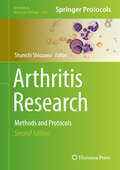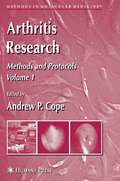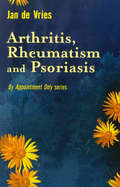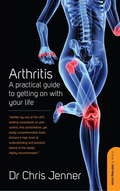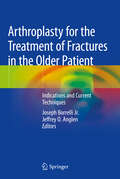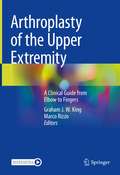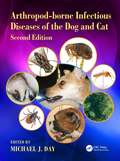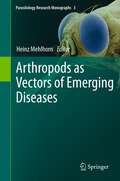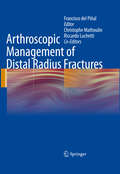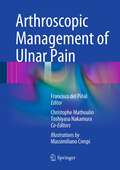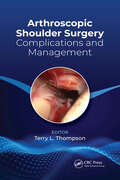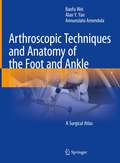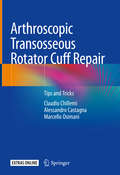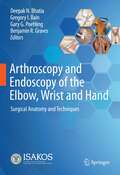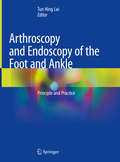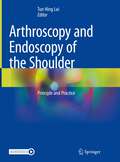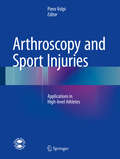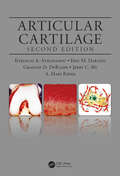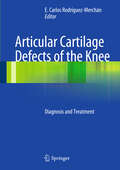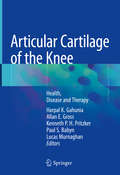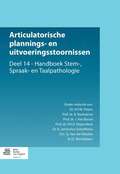- Table View
- List View
Arthritis Research: Methods and Protocols (Methods in Molecular Biology #1142)
by Shunichi ShiozawaArthritis Research: Methods and Protocols, Second Edition expands upon the first edition to present new and current techniques for the research of arthritis and related conditions. A compendium of leaders in the field contribute chapters that cover practical research methods such as the intravital multiphoton microscopy technique, techniques for evaluating exhausted CD8 T cell and for studying nucleic acid sensors and their effects, methods for in vivo tetracycline-controlled transgenic mice and T cell receptor transgenic mice, protocols to detect V(D)J recombination products and microRNA, and the technique to make bleomycin-induced dermal fibrosis. Written in the successful Methods in Molecular Biology series format, chapters include introductions to their respective topics, lists of the necessary materials and reagents, step-by-step, readily reproducible protocols, and notes on troubleshooting and avoiding known pitfalls. Authoritative and easily accessible, Arthritis Research: Methods and Protocols, Second Edition will serve both professionals and novices with state-of-the-art techniques pertaining to this fascinating research field.
Arthritis Research: Volume 1: Methods and Protocols (Methods in Molecular Medicine #135)
by Andrew P. CopeThis is a compendium of data pertinent to the methods and protocols that have contributed to recent advances in molecular medicine in general, but to the molecular basis of rheumatic disease in particular. These volumes details novel technologies, some of which are still evolving and whose impacts are yet to be determined. Leaders in the field contribute to cover exciting and cutting edge topics. This compendium will be a valuable tool.
Arthritis, Rheumatism and Psoriasis
by Jan de VriesArthritis, psoriasis and related rheumatic diseases are an enormous and growing problem throughout the world, with as many as 80 million people suffering from one or another of these conditions. Patients seeking help or relief from their own doctors or hospitals are often informed that they will simply have to live with the problem and that little can be done. In this book, Jan de Vries shows how the problems can be reversed by a simple nutritional and natural approach in which there are none of the terrible side effects that can sometimes accompany a course of drugs. Arthritis, Rheumatism and Psoriasis draws attention to a great variety of home remedies, from homeopathy to herbs, and places particular emphasis on diet as a source of cure.
Arthritis: A Practical Guide to Getting on With Your Life
by Chris JennerArthritis is one of the most common causes of disability, affecting areas in and around the joints and bringing misery to a staggering 10 million people in the UK and 46 million in the USA. Arthritis occurs not just amongst older age groups but across all age ranges, and impacts hugely on the lives of sufferers and their families. Dr Chris Jenner's easy-to-read and highly informative book shows that much of the suffering experienced as a result of this painful condition is unnecessary. Starting with a no-nonsense look at the condition itself, Dr Jenner focuses on the many ways in which arthritis can affect daily life and leads the reader through the variety of options available to sufferers. He shows how the effects of this potentially debilitating disease can be minimised so that quality of life is restored.Contents: Preface; Part I Understanding Arthritis; 1. What is Arthritis?; 2. Arthritis - The Statistics; 3. Types of Arthritis; 4. Related and Secondary Medical Conditions; 5. What Causes Arthritis?; 6. Diagnosing Arthritis; 7. Aggravating Factors; 8. Top Arthritis Myths; Part II Living with Arthritis; 9. The Physical, Emotional and Psychological Impacts of Arthritis; 10. Acceptance Issues; 11. How Relationships Are Affected; 12. Work Issues; 13. Mobility and Disability Issues Benefits and Allowances; 14. Image Issues; 15. Parenting a Child with Arthritis; 16. Support for Arthritis Sufferers; Part III Treating and Managing Arthritis; 17. Pain Management; 18. Medications and Contraindications; 19. Non-Pharmaceutical Treatments 20. The Role of Cognitive Behavioural Therapy; 21. Diet and Lifestyle; 22. Caring for Your Joints; 23. How to Control Stress; Part IV Understanding Medico-Legal Implications; 24. Personal Injury Claims and Arthritis; 25. Medico-Legal Experts and Personal Injury Solicitors; Conclusion; Index.
Arthroplasty for the Treatment of Fractures in the Older Patient: Indications and Current Techniques
by Joseph Borrelli Jr. Jeffrey O. AnglenFocusing exclusively on the older patient with poor bone quality, this unique book presents the indications, contraindications and common techniques – as well as the risks, benefits and outcomes – for utilizing arthroplasty for the treatment of fractures in this population, sensibly divided into four thematic sections. The incidence and burden of fragility fractures is presented in part one, with considerations of the influences of osteoporosis on both treatment and healing. The subsequent three sections cover upper extremity fractures, lower extremity fractures, and peri-articular nonunions, respectively. However, far from providing a simple “how-to” for the techniques discussed, the relevant current literature is presented as well as the common techniques employed in fracture management, allowing the reader to select the best approach for the specific patient presentation. In addition, chapters are included here that cover degenerative joint conditions not typically treated with total joint replacement.The treatment of fragility fractures is constantly evolving, and the aging population is consistently expanding, creating a strong need for clinicians who have experience with and exposure to the use of arthroplasty techniques as an option in their successful treatment. Written and edited by leaders in the field, Arthroplasty for the Treatment of Fractures in the Older Patient is an invaluable resource for orthopedic surgeons, residents and support staff who see and treat these increasingly common injuries.
Arthroplasty of the Upper Extremity: A Clinical Guide from Elbow to Fingers
by Marco Rizzo Graham J. W. KingArthroplasty of the upper extremity is an established surgical intervention in the management of arthritis of the elbow, wrist and hand. The anatomy, kinematics and demands of the elbow, wrist, thumb CMC, and finger MCP and PIP joints pose unique surgical challenges. Implant design considerations are important in providing a joint that mimics the native joints and maximizes survivorship. However, outcomes are less predictable in these upper extremity joints when compared to the hips and knees. Each joint also carries its own set of potential complications and salvage options for revision and failed arthroplasty.This unique text helps the orthopedic and hand surgeon understand the surgical approaches, unique anatomic considerations, and both the historical and current designs related to each respective joint, enabling the surgeon to better appreciate the benefits and limitations of each arthroplasty. Presenting the current state of the art, the seven sections proceed anatomically from the elbow to the fingers, with each section comprised of three thematic chapters discussing implant design considerations, primary arthroscopy techniques and revision arthroscopy techniques, including non-surgical options for treating these often difficult problems. This consistent approach, accompanied by plentiful figures, radiographs and intraoperative photos, ensures that this will be a user-friendly resource for orthopedic and hand surgeons, residents and trainees.
Arthropod-borne Infectious Diseases of the Dog and Cat
by Michael J. DayThis book is an invaluable resource for information on the clinical presentation, pathogenesis, diagnosis and treatment of major arthropod-transmitted diseases of dogs and cats. Illustrated in colour throughout, the book incorporates photographs of clinical cases, haematology, cytology and gross and microscopic pathology, which help understand the diagnosis and treatment of these diseases. The book goes beyond just covering the diseases themselves and also provides information on the arthropods that transmit them. With the effects of climate change and increasing international pet travel, this book will be a valuable addition to every small animal practitioner's library.
Arthropods as Vectors of Emerging Diseases: Arthropods As Vectors Of Emerging Diseases (Parasitology Research Monographs #3)
by Heinz MehlhornGlobal warming and globalization are the buzzwords of our time. They have nearly reached a religious status and those who deny their existence are considered modern heretics. Nevertheless, the earth has become an overcrowded village, traversable within a single day. Thus it is hardly surprising that besides persons and goods also agents of disease are easily transported daily from one end of the world to the other, threatening the health and lives of billions of humans and their animals. Agents of diseases (prions, viruses, bacteria, fungi and parasites) are not only transmitted by body contact or direct exchange of bodily fluids, but also by means of vectors which belong to the groups of licking or blood-sucking arthropods (mites, ticks, insects) that live close to humans and their houses. Without a doubt the recently accelerating globalization supports the import of agents of disease into countries where they never had been or where they had long since been eradicated, leading to a false sense of living on a "safe island." These newly imported or reintroduced diseases - called "emerging diseases" - may lead to severe outbreaks in cases where the countries are not prepared to combat them, or in cases where viruses are introduced that cannot be controlled by medications or vaccines. Arthropods are well known vectors for the spread of diseases. Thus their invasion from foreign countries and their spreading close to human dwellings must be blocked everywhere (in donor and receptor countries) using safe and effective measures. This book presents reviews on examples of such arthropod-borne emerging diseases that lurk on the fringes of our crowded megacities. The following topics show that there is an ongoing invasion of potential vectors and that control measures must be used now in order to avoid disastrous outbreaks of mass diseases.
Arthroscopic Management of Distal Radius Fractures
by Riccardo Luchetti Francisco Del Piñal Christophe MathoulinThe management of distal radius fracture has changed considerably over the past 15 years, particularly with the introduction of wrist arthroscopy and the volar locking plates. The most difficult group of fractures is those where the joint has also been involved, and for those arthroscopy plays an important role. "Arthroscopic Management of Distal Radius Fractures" will be the first one-point reference to comprehensively cover this subject. Instructively illustrated with line drawings, X-rays and clinical photos this hands-on guide depicts novel techniques in general and arthroscopic techniques in particular. The book includes chapters for beginners (e.g. anatomy of portals), as well as the step-by-step descriptions of sophisticated techniques like arthroscopic ulnar reattachment. It helps surgeons explore the possibilities of arthroscopy as well as pick up tricks, in order to master the technique. Additionally, there are chapters discussing the important findings that can only be made with the help of arthroscopy, and which bear prognostic implications and relevance.
Arthroscopic Management of Ulnar Pain
by Francisco Del Piñal Christophe Mathoulin Toshiyasu NakamuraCompared with traditional surgical procedures, wrist arthroscopy reduces the risk to patients and hastens recovery. Nevertheless, in many ways wrist arthroscopy is still in its infancy, and its indications continue to evolve. This book is devoted to the optimal use of arthroscopy in the diagnosis and treatment of wrist pathologies that give rise to ulnar pain. The correct procedure in a wide variety of settings is carefully explained in step-by-step fashion with the help of numerous detailed illustrations. Particular care is taken to cover all the important technical issues. The authors are without exception internationally acknowledged experts who draw on their considerable experience to provide readers with sound guidance on the appropriate use of arthroscopy for each indication.
Arthroscopic Shoulder Surgery: Complications and Management
by Terry ThompsonA comprehensive reference for the current surgical landscape of arthroscopic shoulder surgery, Arthroscopic Shoulder Surgery: Complications and Managementprovides expert opinions on the management of commonly encountered and unusual complications. As there is currently no other up-to-date resource dedicated wholly to complications in shoulder arthroscopy, this will become a go-to resource.Edited by Dr. Terry L. Thompson, alongside expert contributor perspectives on management and preferred treatment, Arthroscopic Shoulder Surgery is a great asset for any practicing orthopedic surgeon performing arthroscopic shoulder surgery, including fellowship-trained shoulder surgeons, sports medicine surgeons, orthopedic surgery residents, and sports medicine and shoulder fellows. By showcasing a broad range of complications and adverse outcomes, this text will assist with cases from adolescents through older adults.Each chapter in Arthroscopic Shoulder Surgery includes: Epidemiology Review of the literature Etiology Author’s preferred treatment with pearls Case presentations including radiographic and surgical images Arthroscopic Shoulder Surgery: Complications and Management is a necessary text discussing one of the most rapidly growing procedures in orthopedic surgery and meeting a need within the orthopedic community to discuss complications. Bringing together literature with tips and tricks from established leaders in shoulder surgery makes this an invaluable resource on handling complications of arthroscopic surgery of the shoulder.
Arthroscopic Techniques and Anatomy of the Foot and Ankle: A Surgical Atlas
by Annunziato Amendola Baofu Wei Alan Y. YanThis expansive, full-color atlas presents the detailed surgical anatomy and approaches for the most commonly performed arthroscopic procedures for the foot and ankle, including detailed descriptions of the equipment and operative set-up for successful arthroscopic procedures. Opening chapters discuss the relevant gross anatomy and instrumentation utilizing both cadaver and intraoperative photos, before proceeding into step-by-step presentations of nearly two dozen surgical procedures, from managing ankle instability and fractures and osteochondral lesions to peroneal tendon repair, plantar fascia release and joint arthrodesis. For each surgical procedure, indications and contraindications are provided, along with appropriate approaches and portals and possible complications. Each chapter is generously illustrated with relevant radiology and intraoperative and arthroscopic photos for maximum visual impact and ease of use, and includes a curated selection of suggested readings for further investigation. An excellent reference for foot and ankle surgeons at every skill level, Arthroscopic Techniques and Anatomy of the Foot and Ankle will be the go-to guide for years to come.
Arthroscopic Transosseous Rotator Cuff Repair: Tips and Tricks
by Marcello Osimani Claudio Chillemi Alessandro CastagnaThe book offers a comprehensive and up-to-date guide to the cutting edge arthroscopic transosseous techniques for the treatment of rotator cuff tears, which are gradually taking over from the common open surgical approach, defined as the gold standard for RCR. With the help of numerous figures, it presents step by step a novel all-arthroscopic anchorless transosseous suture technique that is less invasive and easier to perform. After discussing the etiopathogenesis, histopathology and radiological classification of rotator cuff tears, the book reviews all possible arthroscopic procedures and explores in detail suture management, describing single and double tunnel options. It also examines the complications and post-operative rehabilitation and imaging, while the closing chapter addresses the economic aspects of daily use. Intended primarily for arthroscopic surgeons interested in the field of shoulder joint repair, this exhaustive guide is also a valuable resource for residents and shoulder specialists.
Arthroscopy and Endoscopy of the Elbow, Wrist and Hand: Surgical Anatomy and Techniques
by Gregory I. Bain Deepak N. Bhatia Gary G. Poehling Benjamin R. GravesThis book explores the numerous recent advances in arthroscopic and endoscopic surgery of the smaller joints of the upper extremity – elbow, wrist, and hand. Providing readers with all necessary information, i.e. relevant surgical anatomy and a clear description of technical steps, it uniquely and comprehensively presents arthroscopic and endoscopic techniques of small joints in one publication.The procedures are subdivided according to the pathology (instability, fractures, etc.) or grouped by the region within the anatomical area and include the relevant anatomy, extensive cadaveric dissections, devices and instrumentation, surgical procedures, pearls and pitfalls. High-quality colour illustrations further simplify and complement the description of surgical techniques. Written by pioneers of these techniques, the book is designed to be an up-to-date reference resource for both new and advanced orthopaedic surgeons wanting to become familiar with these techniques.
Arthroscopy and Endoscopy of the Foot and Ankle: Principle and Practice
by Tun Hing LuiThis book provides detailed information in foot and ankle arthroscopy and endoscopy. It explores and introduces these surgical techniques for the treatment of foot and ankle diseases, which have better surgical outcome, lesser surgical morbidity over conventional open surgery. In each chapter, it includes extensive cases and techniques’ illustration about arthroscopy, tendoscopy and endoscopy. Case demonstration with well-illustrated arthroscopic and endoscopic photos for common clinical conditions was provided. It is also written in the same structure and style for each techniques. Step-by-step procedures are complied with pictures and illustrations for easy reference, particularly for surgeons in their clinical practice.
Arthroscopy and Endoscopy of the Hand, Wrist and Elbow: Principle and Practice
by Tun Hing LuiThis book provides detailed advancement on arthroscopy and endoscopy of hand, wrist and elbow. It covers basic knowledge of procedures and dedicated introduction of surgical techniques for disease management. Endoscopic procedures with their advantage in surgical exposure and post-operative rehabilitation have been extensively performed in upper limb diseases. Cases presentation with well-illustrated arthroscopic and endoscopic photos for common clinical conditions was provided. The format is a step-by-step procedure for easy reference, particularly for surgeons in their training.
Arthroscopy and Endoscopy of the Shoulder: Principle and Practice
by Tun Hing LuiThis book provides detailed advancement endoscopy and arthroscopy procedures of shoulder. It covers basic knowledge of procedures and dedicated introduction of surgical techniques for treatment of shoulder diseases with better surgical outcome and less surgical morbidity. Endoscopic and arthroscopic procedures with their advantage in surgical exposure and post-operative rehabilitation have been extensively performed in orthopedic diseases. Cases presentation with well-illustrated arthroscopic and endoscopic photos for common clinical conditions was provided. The format is a step-by-step procedure for easy reference, particularly for surgeons in their training.
Arthroscopy and Sport Injuries: Applications in High-level Athletes
by Piero VolpiThis book describes the current applications of arthroscopy in a very wide range of sports injuries involving, among other sites, the hip, knee, ankle, shoulder, elbow, and wrist. For each condition, mechanisms of injury are explained and the role of arthroscopy in diagnosis and treatment is described. Relevant information is also provided on the epidemiology and mechanisms of injury in specific sports and on indications for treatment and rehabilitation. The book fully reflects the recent advances that have taken place in arthroscopy, permitting more accurate assessment and more successful management of post-traumatic pathologies. Furthermore, it acknowledges that as a result of the increasing use of new technologies and biomaterials, there is now particular interest in techniques that promote biological healing of articular lesions and permit complete functional recovery. The authors are leading specialists in the field who have aimed to provide practitioners with the clear guidance that they require on the evaluation and treatment of injuries incurred during sporting activity.
Arthroscopy: Basic to Advanced
by David Dejour Pietro Randelli Matteo Denti Romain Seil C. Niek van DijkThis book, published in cooperation with ESSKA, is an exceptionally comprehensive guide to arthroscopy that covers all major joints and all potential arthroscopic procedures. Sections on the knee, shoulder, elbow, hip, wrist, and ankle provide in-depth descriptions of each procedure, including indications, technique, complications, and results, as well as essential information on diagnostic work-up and classification systems/rating scales. The text is supported by a wealth of color illustrations, and clear treatment algorithms are included for most sports injuries. An introductory section describes the history of arthroscopy, explains general principles, and provides information on instrumentation, electronic equipment, anesthesia, pain control, and prevention of complications. A special chapter focuses on the operative report, with description of an electronic form that can be used by every surgeon to store operative records or participate in European multicenter ESSKA studies. The authors include the most renowned arthroscopic surgeons in Europe. Arthroscopy will be an invaluable textbook and reference for orthopaedic surgeons, general orthopaedic physicians, sports traumatologists, residents, and physical therapists.
Articular Cartilage (Synthesis Lectures On Tissue Engineering Ser.)
by Kyriacos A. Athanasiou Eric M. Darling Jerry C. Hu Grayson D. DuRaine A. Hari ReddiThis book covers the latest research and advancements related to articular cartilage in biology, development, pathology, clinical applications and tissue engineering. The authors take an interdisciplinary approach that encompasses the breadth and depth of basic science, bioengineering, translational science and detailed methological approaches. It is designed to be an all encompassing encyclopedia of articular cartilage. Written at a level that allows wide accessibility, the book’s comprehensive focus on multiple aspects of articular cartilage sets it apart from other books.
Articular Cartilage Defects of the Knee: Diagnosis and Treatment
by E. Carlos Rodrìguez-MerchánThis book reviews current knowledge on the diagnosis and treatment (surgical and non-surgical) of cartilage defects at the knee joint. In the discussion of diagnosis, the focus is primarily on imaging findings, particularly those obtained with MRI. The remainder of the book is devoted to the full range of current conservative and surgical treatments, with attention to both treatment indications and results as reported in the recent literature. In reviewing non-surgical treatment, oral and intra-articular medical management is evaluated and rehabilitation and physical therapy are also considered. The three main types of surgical technique - microfracture surgery and similar procedures, mosaicplasty and related techniques, and autologous chondrocyte transplantation - are then extensively discussed in a series of highly informative chapters. This book will be of great practical value for clinicians, assisting in daily decision making.
Articular Cartilage of the Knee: Health, Disease and Therapy
by Harpal K. Gahunia Allan E. Gross Kenneth P. H. Pritzker Paul S. Babyn Lucas MurnaghanCovering both pediatric and adult populations, this comprehensive text covers the diverse topics related to the health, disease and therapy of articular cartilage of the knee, from basic principles to future directions for research. This vast array of information is arranged into eight sections, encompassing a number of relevant disciplines and covering, in turn, normal articular cartilage, aging and degeneration, evaluation and assessment, non-surgical approaches, surgical approaches, qualitative and quantitative assessment of repair, research into cartilage repair and engineering, and future prospects for therapy. Each chapter is amply referenced and self-contained for independent study and reference. Scoring systems for knee cartilage assessment are included in four appendices as well, rounding out the presentation.A multidisciplinary collection of basic, translational and clinical material, Articular Cartilage of the Knee is a singular resource for orthopedic surgeons, rheumatologists, pathologists and the broad spectrum of professionals working with articular cartilage.
Articulating Intersex: A Crisis at the Intersection of Scientific Facts and Social Ideals (Philosophy and Medicine #131)
by Natalie DelimataThis book explores the ethical dilemma clinicians may face when disclosing a diagnosis of atypical sex. The moment of disclosure reveals an epistemic incompatibility between scientific fact and social meaning in relation to sex. Attempting to assess the bio-psychosocial implications of this dilemma highlights a complex historic antagonism between fact and meaning making satisfactory resolution of this dilemma difficult. Drawing on David Hume, WVO Quine and Michel Foucault the author presents an integrative model, which views scientific fact and social meaning as codetermining threads in one fabric of knowledge. From this epistemic perspective, the ethical dilemma is understood as a tear in the fabric signifying a rupturing of ontological integrity. To mend this tear and resolve the ethical dilemma three metaphysical perspectives are considered: essentialism, naturalism and emergentism. The book’s unique features include: an exploration of the impact of diagnostic disclosure on people with atypical sex (intersex); a synthesis of the epistemic perspectives of social and natural science facilitating interdisciplinary collaboration; a critical evaluation of three metaphysical perspectives on atypical sex (intersex); the application of Hume’s epistemological and moral distinctions to contemporary biomedicine and bioethics. The book’s target audience includes academics, students and professionals whose work intersects the natural and social sciences, and individuals interested in the metaphysics, epistemology and meta-ethics of sex.
Articulation and Phonological Disorders
by John E. Bernthal Nicholas W. Bankson Peter FlipsenThis is the leading text for courses in clinical phonology-thoroughly revised and updated to include the most current and up-to-date information in the field. Even the newly added subtitle,Speech Sound Disorders in Children, reflects recent changes in the field, including new terminology. This classic text does not prescribe a single approach to phonological disorders but rather presents an eclectic perspective on the nature, assessment, and treatment of this communication impairment. The addition of a third author, Peter Flipsen Jr. , a highly-recognized scholar in the area of clinical phonology, brings important, new information for readers and fresh perspectives to the text. Among the many highlights and special features of the sixth edition are: An entire section devoted to the classification of speech sound disorders; The latest information on Childhood Apraxia of Speech, including a detailed discussion of the 2007 ASHA position statement; A revised and updated comprehensive chapter on Normal Development; A full section on measuring clinical change set within the context of evidence-based practice; An outstanding summary of phonological acquisition information written by leading researcher in this area, Sharynne McLeod; Comprehensive coverage of dialects and phonologic characteristics of speakers with first languages other than English, prepared by leading authorities in this area, Brian Goldstein and Aquiles Iglesias; A completely updated chapter on phonological awareness, co-authored by Laura Justice, Gail Gillon, and C. Melanie Schue. A fully comprehensive and current review of etiological variables, thorough discussion of the assessment of phonologic disorders, and an updated review of broad-based intervention methodologies; and every chapter features introductions, summaries, charts, and graphs to guide learning and aid students' comprehension. The sixth edition of Articulation and Phonological Disorders: Speech Sound Disorders in Children proves once again its "classic" status, and its rightful place on every speech, language, and hearing clinician's bookshelf.
Articulatorische plannings- en uitvoeringsstoornissen: Deel 14 - Handboek Stem-, Spraak- en Taalpathologie
by H.F.M Peters R. Bastiaanse J. Borsel P.H.O. Dejonckere K. Jansonius-Schultheiss Sj. Meulen B.J.E. MondelaersHet Handboek Stem-Spraak-Taalpathologie verscheen tussen 1997 en 2007 gefaseerd in losse afleveringen. Daarin werd alle kennis op het gebied van de stem-, spraak- en taalpathologie vanuit verschillende disciplines samengebracht. Het Handboek is bestemd voor iedereen die klinisch-praktisch of meer theoretisch is geïnteresseerd, of vanuit een ander vakgebied hiermee in aanraking komt. Voor logopedisten, artsen, linguïsten, spraak- en taalpathologen, audiologen, pedagogen en psychologen in Nederland en België is het Handboek een onmisbare vraagbaak.Deel 14 behandelt articulatorische plannings- en uitvoeringsstoornissen. Modellen en vormen, en diagnostiek en therapie komen aan bod.
